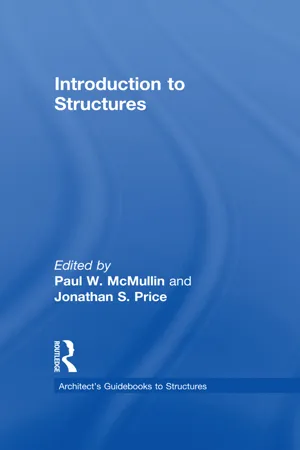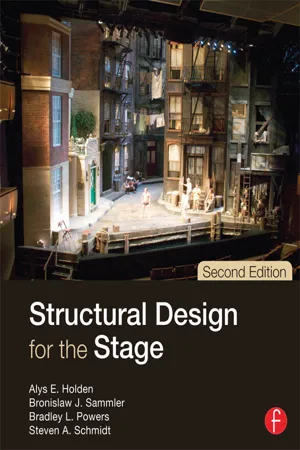Technology & Engineering
Beam Analysis
Beam analysis is the process of studying the behavior of beams under various loads and conditions. It involves calculating the internal forces, stresses, and deflections within the beam to ensure its structural integrity and performance. This analysis is crucial in engineering and construction to design beams that can effectively support the intended loads and meet safety standards.
Written by Perlego with AI-assistance
Related key terms
1 of 5
3 Key excerpts on "Beam Analysis"
- eBook - ePub
- Paul McMullin, Jonathan Price, Paul McMullin, Jonathan Price, Paul W. McMullin, Jonathan S. Price(Authors)
- 2016(Publication Date)
- Routledge(Publisher)
Chapter 9Structural Analysis: BeamsPaul W. McMullinStructural analysis is similar to the practice of accounting. Load and resistance must balance each other, otherwise failure occurs. Balancing the structure at the ground are the foundations. By the time loads reach them, they may have traveled through slabs, beams, girders, columns and connections. In a simple structure, each element in the path can be isolated and analyzed separately.Taking external loads, structural geometry, and material properties, the engineer’s first step is to determine the support reactions, then the internal forces of a structural element. The resulting information is used to design the members, their connections and to determine if deflections will exceed the code limits. Structural analysis inputs into every aspect of member selection.In efficient structures, form responds to the applied forces—not always the case in today’s supposed sustainable architecture. For example, an arch follows the form of an inverted chain; the shape of which depends on the loading and span. Tracing the flow of forces through a structure to the ground is the first broad analysis step. Revising the geometry and reanalyzing the structure are common as designing efficient structures is an iterative process.9.1 SymbolsLet’s discuss the symbols used in analysis. Figure 9.1 presents load and boundary condition symbols representing—in an idealized manner—actual loading and member end supports. Open arrows denote reactions; closed arrows applied loads.Loads fit into four categories:- Area load : A force applied over an area (units of lb/ft2 , kN/m2 )—like on a floor. The magnitude can vary across the area (think of snow drifts).
- Distributed load
- eBook - ePub
- Alys Holden, Bronislaw Sammler, Bradley Powers, Steven Schmidt(Authors)
- 2015(Publication Date)
- Routledge(Publisher)
3 Stress Analysis for BeamsDOI: 10.4324/9781315697857-3Introduction
Beam Stress
Beams are structural members which are subject to tangential loads. Tangential loads act perpendicular to the axis of a member and cause bending (flexure), vertical shear, and horizontal shear stresses to develop in a beam. As discussed in Chapter 2 , bending stress is actually a combination of tensile and compressive stresses. However, instead of analyzing the tensile and compressive stresses separately, bending stress can be treated as a whole with its own allowable stress design value. Bending stress is dependent on the loading condition on the beam and the resulting moment, and the shape of the beam. In this chapter, we will discuss how to calculate the magnitude of the bending and shear stresses generated by tangential loads on beams. In the next chapter we will discuss how to calculate the capacity of a shape to resist stresses.Types of Beam Failure
Beams can fail catastrophically in three ways: bending, horizontal shear, or vertical shear. Structural designers must analyze all three stresses in beams to be sure that they are safe.-
When a beam fails due to bending stress, the bottom fibers of the beam literally pull apart. A beam is more likely to fail due to bending stress if it has a relatively long span.
Figure 3.1a Bending stressShape affects a beam’s resistance to bending stress. A 2×4 beam oriented on edge will resist bending better than a 2×4 oriented flat, which is why 2×4 framed platforms are built with the framing on edge (3.5″ high).
-
When a beam fails due to horizontal shear, the top and bottom fibers slide past each other at the middle of the beam’s cross-section. Short beams are more likely to fail due to horizontal shear.
For solid sections, horizontal shear stress is not dependent on shape, only on cross-sectional area. An indication of failure due to horizontal shear would be a crack in the middle of a wooden beam, often following the grain of the lumber.
- eBook - ePub
- A Nash, Alec Nash(Authors)
- 2017(Publication Date)
- Routledge(Publisher)
Chapter 3BEHAVIOUR OF BASIC STRUCTURAL ELEMENTSThe majority of built forms in architecture consist of rectilinear spaces. The greater part of most people’s lives are spent in spaces bounded by horizontal and vertical planes. An appreciation of the behaviour of structural elements should therefore originate in the simple beam and column, both of which involve tension, compression and bending as described in Chapter 2 .Beams
Horizontal elements subject to bending
A structural element lying in a horizontal plane and subjected to vertical forces is commonly referred to as a beam. Using the vector notation introduced in Chapter 1 , with downward pointing arrows representing gravitational forces and upward pointing arrows representing reactions, there are clearly numerous arrangements of loads and reactions that can be described as beams. A few of these are shown in Figure 3.1 .What all these arrangements, and countless others, have in common is that they all serve the purpose of moving vertical forces sideways to predetermined positions, that is to the supporting columns, walls and piers. The effect that these vertical forces have on the horizontal element, the beam, is to make it bend. The design, or the evaluation of the required size, of a beam must therefore be informed by the manner in which the bending effect caused by the external forces is resisted by the strength inherent in the beam.Figure 3.1Beam loading systemsThe effect produced by the external forces, including both loads and reactions, can be expressed as the bending moment, defined in Chapter 1 . The term ‘bending moment’ was seen to be a function of the loading on a beam and its support positions. The more complicated the loading, the more lengthy are the calculations necessary to locate the position of maximum bending moment and to evaluate its magnitude. In most cases which occur in architecture, however, the design loading is based on assumptions which allow the use of the simpler load distribution patterns. The majority of beam design calculations can be carried out using the uniformly distributed load (UDL) or the central point load, for which the maximum bending moment can be quickly worked out from the formulae derived in Chapter 1
Index pages curate the most relevant extracts from our library of academic textbooks. They’ve been created using an in-house natural language model (NLM), each adding context and meaning to key research topics.


